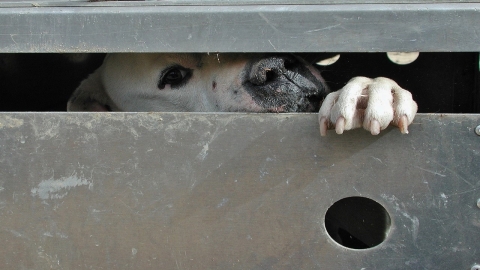Animal Cruelty Prevention Month
Courtesy of John C. Cruden, Assistant Attorney General for the Environment & Natural Resources Division
 April is widely recognized by many national and local organizations as a time to renew awareness of the issue of animal cruelty. The images that we often see of animal cruelty cases can be profoundly disturbing – they strike a deep chord within us and raise concerns about related crimes, including interpersonal abuse. But the issue of animal welfare is not purely a local one, confined to the treatment of household pets. Animal welfare is also an important national issue that has a long history in American law, dating back to the early colonial era. At the federal level, Congress has repeatedly made clear that ensuring the humane treatment of animals – whether by a zoo, commercial breeder, horse show, laboratory, or even a slaughterhouse – is a national policy. And it is a policy that carries with it enforcement responsibilities.
April is widely recognized by many national and local organizations as a time to renew awareness of the issue of animal cruelty. The images that we often see of animal cruelty cases can be profoundly disturbing – they strike a deep chord within us and raise concerns about related crimes, including interpersonal abuse. But the issue of animal welfare is not purely a local one, confined to the treatment of household pets. Animal welfare is also an important national issue that has a long history in American law, dating back to the early colonial era. At the federal level, Congress has repeatedly made clear that ensuring the humane treatment of animals – whether by a zoo, commercial breeder, horse show, laboratory, or even a slaughterhouse – is a national policy. And it is a policy that carries with it enforcement responsibilities.
As part of DOJ's law enforcement mission, we play a role in the enforcement of a number of federal animal welfare laws, along with key partners such as the U.S. Department of Agriculture. One such area has been our effort to combat underground dog fighting schemes, where drug trafficking, gun running, and gang activities are commonplace. It is astonishing to hear some estimates reveal that there are over 40,000 active professional dog fighters in the United States. Over the years, the U.S. Attorney's Offices have charged hundreds of defendants involved in these illegal animal fighting ventures. In 2014 alone, DOJ pursued ten dog fighting cases and charged 49 defendants, marking a significant upswing in federal enforcement. Cases like United States v. Anderson – brought by the U.S. Attorney's Office for the Middle District of Alabama – highlight the seriousness of this crime. Anderson involved the second largest dog fighting raid in U.S. history, with over 400 dogs seized, 13 defendants indicted, sentences as high as eight years, and a restitution order of $2 million for the care of the seized animals.
In recent years, DOJ has also worked to enhance federal coordination and support our state and local law enforcement partners on a variety of animal welfare issues. DOJ's Office of Community Oriented Policing Services (COPS) has helped over 1,500 law enforcement professionals to better detect, investigate, and take action against dog fighting through an online training program developed in partnership with the American Society for the Prevention of Cruelty to Animals. And in 2014, FBI Director James Comey announced a historic change in the identification and reporting of animal cruelty crimes. For the first time, rather than being categorized as miscellaneous offenses, animal cruelty crimes will be distinctly reported as such in the National Incident-Based Reporting System (the FBI's crime statistics database). This change will enable law enforcement, researchers, and policymakers to better understand and respond to these crimes.
Finally, as Assistant Attorney General for the Environment and Natural Resources Division, I am particularly pleased that late last year, DOJ designated this Division as the centralized body within DOJ that will help track, coordinate, and work with the U.S. Attorney's Offices on animal cruelty enforcement matters. These are only first steps, and we have more work to do. But we will not turn a blind eye to those who violate these important, long-standing federal laws that protect the vulnerable and voiceless.

 U.S. Department
of Justice
U.S. Department
of Justice
